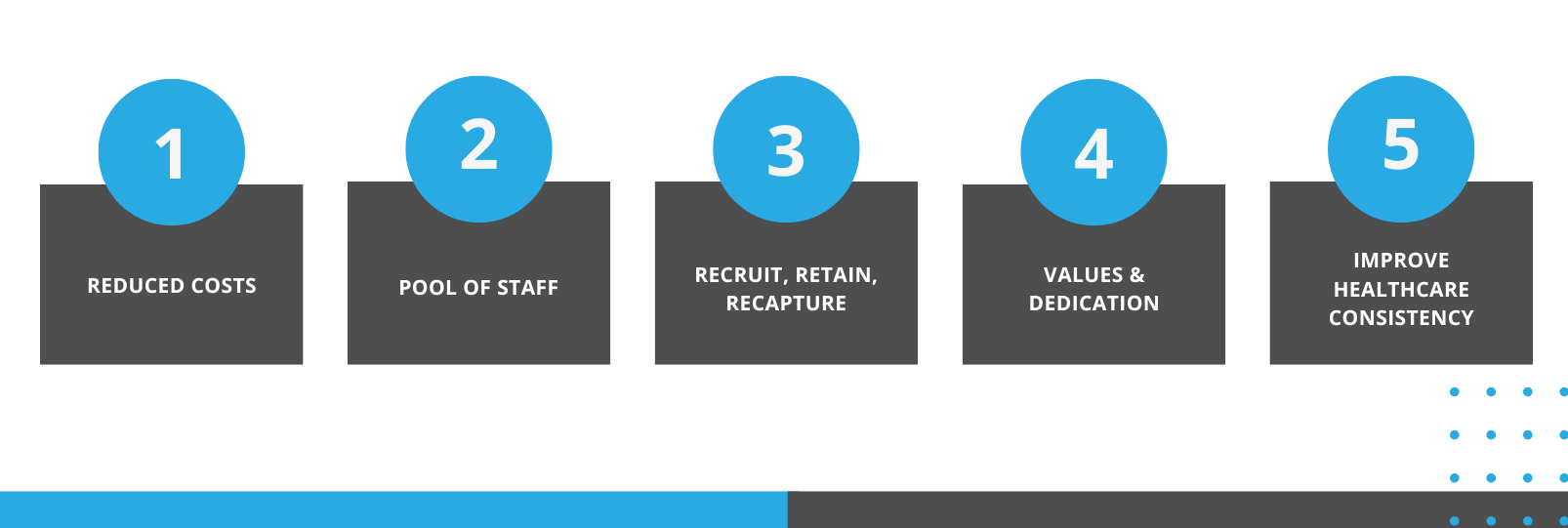In early June 2022, Staffing Industry Analytics (SIA) reported how an 85% increase in healthcare temporary staffing led to $39.8 billion in expenses for 2021. In response to increased demand for skilled workers, use of contingent labor, steep hourly wages, and anticipated healthcare shortages well into 2025, many healthcare institutions are turning to internally operating their own contingent staffing programs.
An 85% increase in healthcare temporary staffing led to $39.8 billion in expenses for 2021.
Shifting staffing efforts into internally operated processes offers several competitive advantages to healthcare systems, as well as traveling workers. Turning to an in-house sourcing system is appealing to many organizations due to the ability to manage staffing, mitigate costs, and avert shortages. As enticing as these factors are, in-house staffing models face several challenges that can make or break internal staffing efforts if overlooked.
Fortunately, obstacles in-house staffing models face can be facilitated with proper technology to ease the transition and set healthcare systems up for long term success.
What is the In-House Staffing Model?
The in-house staffing model means that in lieu of relying on service providers to fill staffing needs, healthcare organizations are designing their own travel programs and recruitment efforts to deploy workers to their own affiliated hospitals in need of clinicians.
For example, the University of Pittsburgh Medical Center (UPMC) launched its own in-house staffing model in late 2021. With 40 facilities scattered throughout 3 states, UPMC’s internal staffing agency will send traveling staff to where needs are greatest within their own network of healthcare systems.
This strategic approach is powerful not only in saving costs and managing all steps of the recruitment process, but it provides a mechanism for facilities to gain reliable employees for the long-term – a main objective of UPMC’s initiative to turn in-house.
Many healthcare systems shifting to in-house models offer beneficial wages that are both sustainable to the institution and still appealing to caregivers. UPMC is also offering travel stipends, benefits, and in some cases, tuition reimbursements. Furthermore, such institutions are also rewarding their own permanent staff to encourage morale and retain their long-term workers, rather than losing them to travel opportunities.
As tempting as it is to jump on the in-house trend, it’s essential to acknowledge the many challenges internally operated staffing agencies face in the healthcare industry, along with solutions to mitigate these obstacles.
In-house Staffing Benefits for Healthcare Organizations

1. Reduced Costs
The onset of the pandemic saw a large demand for healthcare workers, with shortages stemming from several causes including retirement, burnout, and population shifts. This led to exorbitant rates for clinicians amounting to almost three times pre-pandemic rates in certain cases. In-house staffing agencies can experience reduced labor expenses and take action in mitigating costs. For example, UPMC claimed that through their in-house staffing initiative, they were able to hire two of their own clinicians for the price of a single contracted candidate.
2. Pool of Staff
In-house staffing models have the benefit of building a pool of staff that serve as a safety net in unexpected events or addressing shortage fluctuations. Having a retainment of skilled talent means that in the case of future pandemics, crises, or seasonal fluctuations of hospital staff, institutions are prepared to allocate and deploy staff on hand to avert shortages. Additionally, with clinicians on hand, there is less time to wait on screening, credentialing, and training when transitioning from flotation locations.
3. Recruit, Retain, and Re-Capture
Proper recruitment is one of the most difficult factors healthcare organizations face. The ability to recruit quality candidates and subsequently retain skilled workers is a major competitive advantage for internal staffing programs. Many factors contribute to employee retention and by empowering employees with work flexibility to pursue travel opportunities, career growth, and short-term commitments, organizations can enable greater retention. Travel employees can explore several niches professionally and geographically that suit them, which can potentially convert staff into long-term employees for your organization. Additionally, re-capturing previous employees who left in favor of travel opportunities is a competitive opportunity in-house staffing agencies can leverage.
4. Values & Dedication
Travel staff hired internally understand company values, practices, and culture. By incorporating staff into travel programs, you’ll have a workforce that has greater dedication and loyalty to your organization than external, temporary staff might exhibit.
5. Healthcare Consistency
With staff frequenting different locations, there is opportunity for travel caregivers to identify areas that healthcare systems fall short in comparison to other locations. This allows for greater improvement and consistency between locations, boosting your organization’s brand reputation.
Benefits to Healthcare Employees

Work Flexibility
Greater work flexibility is an appealing factor when it comes to travel nursing and related healthcare professions. The ability to have shorter commitments and a change of scenery provides travel workers the opportunity to explore regions and clinical positions they may better thrive in.

Competitive Pay
The greatest component to travel nursing are competitive wages. Travel staff benefit with hourly wages reflecting travel demand and efforts, as well as stipends and benefits. Furthermore, institutions turning to in-house staffing models are rewarding permanent staff for remaining in permanent positions rather than opting to travel.

Professional & Career Advancement
Internally managed travel programs offer professional advantages to travel workers by enabling career growth and allowing workers to retain their seniority within their organization. Traveling to different locations gives the traveling workforce opportunities to network and build professional connections.
Challenges in Internal Staffing & VMS Solutions
Internally operated staffing programs provide organizations with numerous competitive advantages. Without a proper contingent workforce program foundation set in place, many facilities run the risk of in-house staffing programs deterioriating quickly. With expert guidance and a well-crafted strategy, healthcare organizations can avoid the common challenges in-house operations face which include:
- Implementing improper technology
- Balancing pay between travel workers and permanent employees
- Greater coverage gaps created for traveling opportunities
- Monitoring demand and anticipating future needs
- Seamlessly transitioning contingent staff into healthcare facilities
- Crafting an improper strategy unique to your organization
Improper Technology
Traditional HR methods and manual processes for contingent recruitment are inefficient in addressing the growing needs and nuances in contingent staffing. With multilayered processes involved in recruiting, effective, fast, and accurate technology is paramount for efficient and quality staffing.
Organizations may consider implementing vendor management systems (VMS) to centralize siloed data and spreadsheets into a single location. This allows for quick access to records, documentation, and data between departments.
For Human Resources and hiring managers, a VMS facilitates a seamless requisition cycle in which all steps of the recruitment process can be completed through a single platform. This includes automating requisitions, matching candidates, interviewing, onboarding and credentialing, as well as time management and consolidated billing. Automated solutions mean quicker fill rates and maximized productivity.
Additionally, a VMS empowers in-house staffing programs by alleviating unnecessary spend. This is because a VMS provides transparent oversight into an organization’s spend, but also visibility into actual market rates that inform your organization on real-time rates for specific occupations. Furthermore, a VMS with geographical capabilities, such as StaffBot’s rate intelligence tools, will ensure you mitigate costs based on market rates by region – an important factor as many healthcare organizations have facilities scattered throughout multiple regions.
Balance of Pay
Balancing pay that is sustainable for the organization while maintaining appeal to travel candidates is a challenging task when market rate visibility is low. Furthermore, pay disparities between permanent staff and traveling employees is a source of contention. Finding a balance between market rate wages with rates that reflect fair compensation for travelers uprooting to cover shortages is not a simple feat.
A powerful way to overcome pay discrepancies is the ability to see market rate analytics. Vendor management systems are equipped to analyze geographical market rate to help organizations determine fair, informed wages. With visibility into real-time rates for specific healthcare positions, your organization can seize the opportunity to mitigate and save immense costs. In fact, according to the SIA, 76% of companies reported experiencing cost reductions and increased overall savings through the use of a VMS.
Coverage Gaps
The appealing advantages offered in travel healthcare run the risk of healthcare workers migrating from permanent staff to travel opportunities. Sudden shifts could leave facilities in low capacity causing gaps in coverage. A major concern is the loss of labor in smaller, less attractive facilities for more favorable opportunities.
Correspondingly, travel employees are concerned with the burden of being excessively sent on travel opportunities to cover severe shortages if the healthcare facility has too much control on their schedules.
Monitor Demand
Understanding the varying facets of demand at each hospital is a challenge internal workforce management face. Understanding the behavior of each hospital, clinical specialty, and seasonality of workforce demand can enable your organization to be prepared in addressing fluctuating job market demand.
Seamless Transitions
With travel workers constantly rotating between facilities, a seamless integration between facilities can be challenging. Efficient transitions between locations are key for consistent experiences. Internal staffing agencies want to ensure their travel workforce are properly trained and updated for the specific location they’re assigned to.
Improper Strategy
Installing VMS technology doesn’t ensure success for internally operated staffing facilities if there isn’t a strategic approach set in place on how the recruitment process operates in conjunction with VMS technology.
Conclusions
The use of contingent workforce is a trend expected to rise, with 83% of global executives reporting an increased use of contingent workforce in companies. This sentiment is particularly applicable to the healthcare workforce, an industry that has suffered severe shortages and greater reliance on contingent labor.
Transitioning staffing operations into internally managed processes offers several competitive advantages, however many organizations fail to address the challenges associated with in-house staffing, resulting in wasted efforts, resources, and time. With proper technology and guidance, in-house staffing models have the potential to thrive and improve return on investment, as well as recruit, retain, and re-capture employees to create a sustainable workforce ready to address current and future shortages, crises, or future pandemics.
Connect with an expert or request a demo
"*" indicates required fields





0 Comments